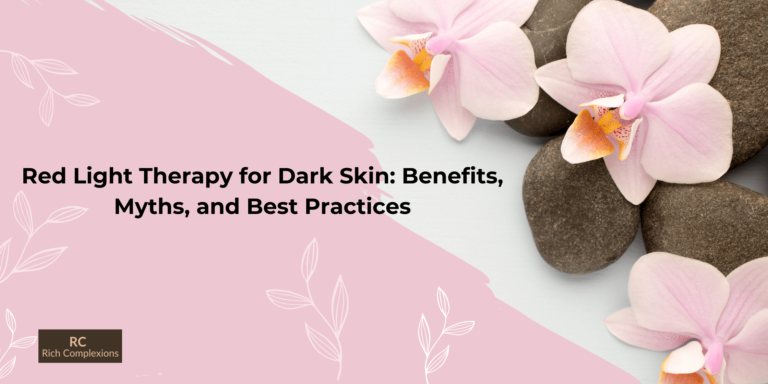Red light therapy (RLT) has gained popularity for its wide range of health and beauty benefits, from reducing inflammation to enhancing skin rejuvenation. However, when it comes to darker skin tones, there’s often a lack of clear, accurate information. Myths and misconceptions abound, leaving many unsure whether RLT is effective or even safe for them.
In this article, we will explore the benefits of red light therapy specifically for dark skin, debunks common myths, and offers best practices to ensure you get the most out of your treatment.
Whether you’re curious about improving hyperpigmentation, boosting collagen production, or simply enhancing your overall complexion, understanding how RLT works for your skin type is crucial for achieving optimal results.
Understanding Red Light Therapy
Red light therapy uses low-level wavelengths of red light, typically between 620-750 nanometers, to penetrate the skin. This light energy is absorbed by the cells, stimulating various biological processes, such as collagen production, improved circulation, and cellular repair. Unlike UV light, red light therapy does not cause skin damage or increase the risk of skin cancer.
Benefits of Red Light Therapy for Dark Skin
i. Even skin tone and hyperpigmentation
Darker skin tones are more prone to hyperpigmentation, where certain areas of the skin become darker than the surrounding areas due to an overproduction of melanin. Red light therapy can help by reducing inflammation and promoting an even skin tone over time.
ii. Collagen production and anti-aging
One of the primary benefits of red light therapy is its ability to boost collagen production. Collagen is crucial for maintaining skin elasticity and firmness, which is especially important for dark skin, as it tends to show signs of aging differently than lighter skin tones.
iii. Reduction in acne and acne scars
Darker skin is more susceptible to post-inflammatory hyperpigmentation (PIH) after acne, where dark spots remain after the acne heals. Red light therapy can reduce inflammation, minimize acne outbreaks, and speed up the healing process, reducing the chances of developing PIH.
iv. Improved skin texture and tone
Regular red light therapy sessions can help improve overall skin texture, making the skin appear smoother and more radiant. This is particularly beneficial for individuals with dark skin who may experience rough patches or uneven texture.
Common Myths About Red Light Therapy and Dark Skin
- Myth: Red Light Therapy Can Cause Hyperpigmentation in Dark Skin: A common misconception is that red light therapy can worsen hyperpigmentation in dark skin. However, this is not supported by scientific evidence. Red light therapy has a low risk of side effects and does not emit UV rays, which are typically responsible for worsening pigmentation issues.
- Myth: Red Light Therapy is Less Effective on Dark Skin: Another myth is that red light therapy is less effective on darker skin tones due to the higher levels of melanin. While melanin does absorb light, the wavelengths used in red light therapy are still capable of penetrating the skin deeply enough to be effective, regardless of skin tone.
- Myth: Darker Skin Needs Longer Exposure to See Results: Some believe that darker skin tones require longer exposure to red light therapy to achieve the same results as lighter skin tones. In reality, the effectiveness of red light therapy depends on consistent use and proper device settings rather than skin tone.
Best Practices for Using Red Light Therapy on Dark Skin
i. Consult with a dermatologist
Before starting any new skin treatment, it’s important to consult with a dermatologist, especially if you have concerns about how your skin may react to red light therapy.
ii. Start with short sessions
For those new to red light therapy, it’s advisable to start with short sessions, typically around 5-10 minutes, and gradually increase the duration as your skin adjusts.
iii. Follow device instructions carefully
Each red light therapy device has specific guidelines for use. Follow the manufacturer’s instructions carefully to ensure you are using the device safely and effectively.
iv. Consistency is key
To see the best results, consistency is crucial. Regular sessions, usually 2-3 times a week, are recommended for optimal benefits.
v. Use a moisturizer after treatment
After each session, apply a moisturizer to keep your skin hydrated. This is particularly important for dark skin, which can be prone to dryness.
Conclusion
Red light therapy offers numerous benefits for individuals with dark skin, including improved skin tone, reduced hyperpigmentation, and enhanced collagen production. While myths and misconceptions persist, the science supports the safety and efficacy of red light therapy for all skin tones.
By following best practices and consulting with a skincare professional, individuals with dark skin can effectively incorporate red light therapy into their skincare routine for healthier, more radiant skin.



